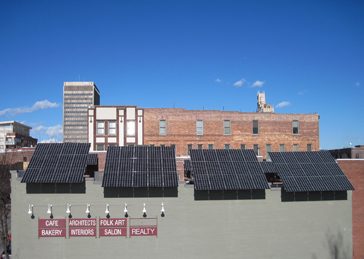As design professionals, our focus is on providing clients the highest level of sustainable design and construction. The true test of practicing what we preach, however, comes from the internal operations of our businesses. Do we promote a sustainable ethos within our studios and offices? This is where a Sustainable Action Plan is helpful.
The LEED Existing Buildings Operations and Management (EBOM) and the Asheville Workplace Challenge provide an excellent framework for guidelines on drafting a Sustainable Action Plan tailored to individual organizations.
LEED EBOM provides a more detailed checklist for sustainability, with acknowledgement of pest control, landscaping, sustainable products, green cleaning, and occupant comfort. More information can be found at www.usgbc.org/leed.
The Asheville Workplace Challenge is a regional sustainable operations plan promoted by the City of Asheville. It awards points for high levels of achievement in company internal policy, energy efficiency, water conservation, waste reduction, and transportation. Learn more about this initiative at www.asheville.municipalchallenge.com.
Another regional program that helps local organizations achieve environmental sustainability is Appalachian Offsets. This Green Built Alliance program gives organizations and individuals a way to offset their carbon emissions by paying into a community fund that makes energy-efficiency improvements within local nonprofits, schools, and low-income housing. Users can make contributions based on how much carbon they emit, calculating their share with a user-friendly application online at www.cutmycarbon.org.

At our firm, we have synthesized the sustainable tenets of all three programs, creating a practical Sustainable Action Plan. Our sustainability policy includes an environmentally preferable office supply purchasing policy, a contract with a composting service, promoting energy efficiency internally by encouraging employees to maximize the use of natural light in our studio, and establishing a regular cleaning schedule for the 21kW solar array on the roof of our building.
In the past year and a half that these efforts have been in place, we have seen an almost 50 percent reduction in energy use, on average. The energy usage that remains has been offset by participation in Appalachian Offsets, officially making our office carbon-neutral. With the compost pickup service, our office landfill waste has easily been cut in half.
Defining commitment to environmental responsibility in quantifiable terms allows businesses to measure and improve their performance—an excellent way to ensure environmentally preferable practices internally as well as externally. A Sustainable Action Plan is a simple way to exemplify the sustainability tenets that we strive to promote in our community.
Margaret Chandler is an architect with Samsel Architects. She has worked in sustainable design since earning her degrees at Clemson University, and briefly lived in a treehouse off the grid in Austin, TX. Margaret currently serves as Treasurer on the AIA Asheville Executive Committee.
You can also view this article as it was originally published on page 63 of the 2017-18 edition of the directory.


